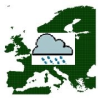Europe
Type of resources
Available actions
Topics
Keywords
Contact for the resource
Provided by
Years
Representation types
Update frequencies
status
-

Couche récupérée au CRU (Climatic Research Unit - http://www.cru.uea.ac.uk/) contenant des données sur la pluviométrie. Les données représentent des valeurs mensuelles (1901 - 2000) sur le territoire européen avec un maillage au pas de 10 minutes (maille de 18,5 km en latitude x 13,1 km en longitude [à 45°]). Elles sont exprimées en mm de précipitation (stockage dans la table t_cru12_precip_mm_1901_2000_cpe de la base de données db_sigeco hébergée sur le serveur pggeodb.nancy.inra.fr)
-

Couche récupérée au CRU (Climatic Research Unit - http://www.cru.uea.ac.uk/) contenant des données sur la température moyenne. Les données représentent des valeurs mensuelles (1901 - 2000) sur le territoire européen avec un maillage au pas de 10 minutes (maille de 18,5 km en latitude x 13,1 km en longitude [à 45°]). Elles sont exprimées en degrés celsius (stockage dans la table t_cru12_temp_moy_celsius_1901_2000_tmp de la base de données db_sigeco hébergée sur le serveur pggeodb.nancy.inra.fr)
-
(i) Context:The ICP Forests database is probably the most comprehensive forest ecosystem database in Europe and contains the accumulated results of several decades of harmonised monitoring all over Europe. (ii) Aims: Goal of this paper is to open the soil information of the ICP Forests Level II plots for broader use among forest scientists. (iii) Methods: The soil data were gathered according to the ICP Forests manual, purified, validated, and aggregated to meaningful variables and summarizing soil properties. (iv) Main features and potential use of database: The aggregated Level II forest soil database provides the occasion for the combined evaluation of up to 130 unique soil variables per plot with dynamic data on tree growth, ground vegetation, foliage chemistry, crown condition, tree phenology, leaf area index, ground vegetation, ozone injury, litterfall, soil solution, deposition, ambient air quality, and meteorological data assessed on the same plots. (v) Conclusions:The database covers nearly all member states of the European Union, but it is not representative for this area in terms of tree species and soil types due to the original selection criteria for the plots.
-
We developed a dataset of the potential distribution of seven ecologically and economically important tree species of Europe in terms of their climatic suitability with an ensemble approach while accounting for uncertainty due to model algorithms. The dataset was documented following the ODMAP protocol to ensure reproducibility. Our maps are input data in a decision support tool “SusSelect” which predicts the vulnerability of forest trees in climate change and recommends adapted planting material.
 Agroenvgeo (INRA)
Agroenvgeo (INRA)